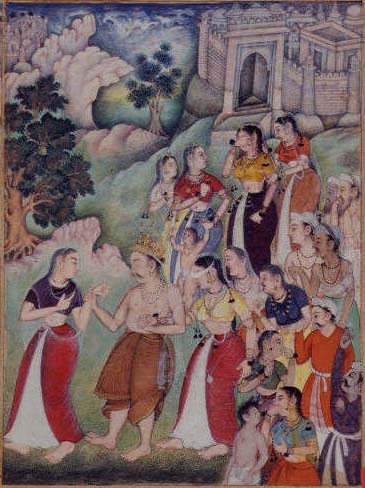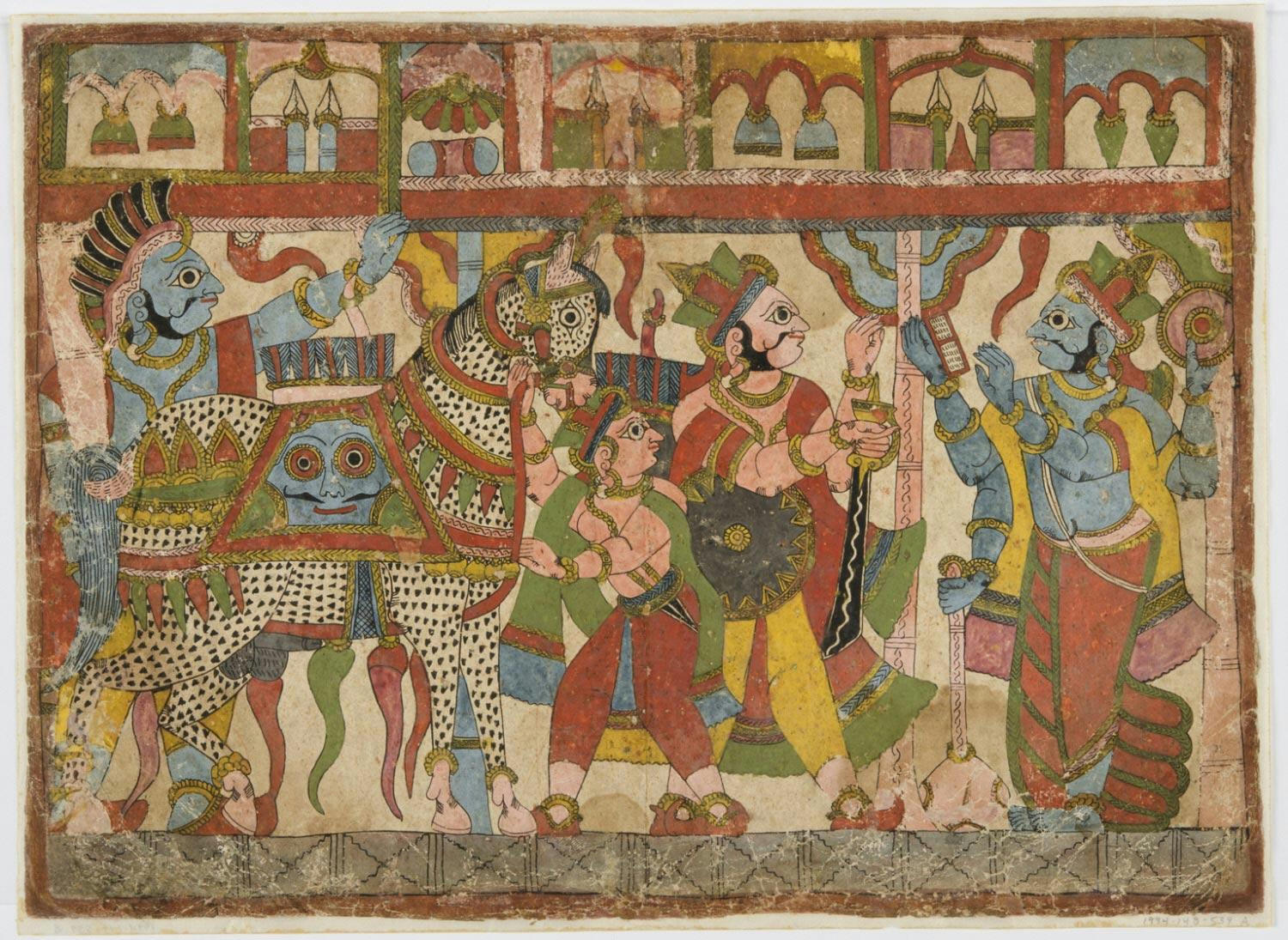|
Ashramavasika Parva
The Ashramvasika Parva () ("Book of the Hermitage") is the fifteenth of the eighteen ''parvas'' (books) of the Indian epic ''Mahabharata''. It traditionally has 3 parts and 39 chapters.Ganguli, K.M. (1883-1896)Asramavasika Parva in ''The Mahabharata of Krishna-Dwaipayana Vyasa'' (12 Volumes). CalcuttaDutt, M.N. (1905) ''The Mahabharata (Volume 15): Ashramavasika Parva''. Calcutta: Elysium Press The critical edition has 3 parts and 47 chapters. The ''Ashramvasika Parva'' describes the fifteen years of prosperity under Yudhishthira following the great war. The five Pandavas live in amity with the survivors of their uncle's family, with Yudhishthira scrupulously consulting Dhritarashtra on matters of governance. Draupadi becomes friends with Gandhari, Vyasa and other sages visit the kingdom with their fables and wisdom. The parva recites the next two years when Dhritarashtra and Gandhari take ''sannyasa'' and live a hermit's life in a forest.John Murdoch (1898), The Mahabharata - An ... [...More Info...] [...Related Items...] OR: [Wikipedia] [Google] [Baidu] |
Jaimini
Jaimini was an ancient Indian scholar who founded the Mīmāṃsā school of Hindu philosophy. He is the son of Parāśara and is considered to be a disciple of sage Vyasa. Traditionally attributed to be the author of the '' Mimamsa Sutras''James Lochtefeld (2002), The Illustrated Encyclopedia of Hinduism, Vol. 1 & 2, Rosen Publishing, , pages 438, 437-438, 746 and the '' Jaimini Sutras'', he is estimated to have lived around 4th to 2nd century BCE. Some scholars place him between 250 BCE and 50 CE. His school is considered non-theistic,FX Clooney (1997), What’s a god? The quest for the right understanding of devatā in Brāhmaṅical ritual theory (Mīmāṃsā), International Journal of Hindu Studies, August 1997, Volume 1, Issue 2, pages 337-385 but emphasizes ritual parts of the ''Vedas'' as essential to ''dharma''.P. Bilimoria (2001), Hindu doubts about God: Towards Mimamsa Deconstruction, in Philosophy of Religion: Indian Philosophy (Editor: Roy Perrett), Volume 4, Routl ... [...More Info...] [...Related Items...] OR: [Wikipedia] [Google] [Baidu] |
Mausala Parva
The Mausala Parva ("Episode of Flails") is the sixteenth of the eighteen ''parvas'' (books) of the Indian epic ''Mahabharata''. It traditionally has nine chapters.Ganguli, K.M. (1883-1896)Mausala Parva in ''The Mahabharata of Krishna-Dwaipayana Vyasa'' (12 Volumes). CalcuttaDutt, M.N. (1905) ''The Mahabharata (Volume 16): Mausala Parva''. Calcutta: Elysium Press The critical edition has eight chapters. It is one of the three shortest episodes within the epic. The Mausala Parva describes the demise of Krishna in the 36th year after the Kurukshetra War had ended, the submersion of Dvaraka under the sea, the death of Balarama by drowning in the sea, Vasudeva's death, and a civil war fought among the Yadava clan that killed many of them. The story of infighting of the Yadavas becomes the reason why the Pandava brothers renounce their kingdom and begin their walk towards heaven, events recited in the last two books of the Mahabharata.John Murdoch (1898), The Mahabharata - An English A ... [...More Info...] [...Related Items...] OR: [Wikipedia] [Google] [Baidu] |
Ashvamedhika Parva
The Ashvamedhika Parva () is the fourteenth of the eighteen ''parvas'' (books) of the Indian epic ''Mahabharata''. It traditionally has 2 parts and 96 chapters.Ganguli, K.M. (1883-1896)Aswamedha Parva in ''The Mahabharata of Krishna-Dwaipayana Vyasa'' (12 Volumes). CalcuttaDutt, M.N. (1905) ''The Mahabharata (Volume 14): Ashwamedha Parva''. Calcutta: Elysium Press The critical edition has one sub-book and 92 chapters. Ashvamedhika Parva begins with advice from Krishna and Vyasa who recommend Yudhishthira to perform the Ashvamedha ceremony. Yudhishthira discloses that the treasury is empty because of the war. Krishna suggests mining gold in Himavat, near mount Meru. He recites the story of king Muratta. Yudhishthira proceeds with the effort to mine gold, fill his treasury and perform the Ashvamedhika ceremony.John Murdoch (1898), The Mahabharata - An English Abridgment, Christian Literature Society for India, London, pages 121-123 The book includes Anugita parva, over 36 chapters ... [...More Info...] [...Related Items...] OR: [Wikipedia] [Google] [Baidu] |
Vaisampayana
Vaishampayana (, ) is the traditional narrator of the ''Mahabharata'', one of the two major Sanskrit epics of India. He was one of Vyasa's four main disciples. His nephew and disciple, Yajnavalkya, who was also a well-known sage. Legend Vaishampayana is a renowned sage who is stated to be the original teacher of the ''Krishna Yajur-Veda:'' The ''Ashvalayana Grihya Sutra'' mentions him as ''Mahabharatacharya''. He is also mentioned in the '' Taittiriya Aranyaka'' and the '' Ashtadhyayi'' of Pāṇini. Vyasa Vyasa (; , ) or Veda Vyasa (, ), also known as Krishna Dvaipayana Veda Vyasa (, ''Vedavyāsa''), is a ''rishi'' (sage) with a prominent role in most Hindu traditions. He is traditionally regarded as the author of the epic Mahabharata, Mah� ... is regarded to have taught the ''Mahabharata'' of 100,000 verses to Vaishampayana. He is regarded to have recited the epic to King Janamejaya at his ''sarpa satra'' (snake sacrifice). The Harivamsha Purana is also reci ... [...More Info...] [...Related Items...] OR: [Wikipedia] [Google] [Baidu] |
Writers Workshop (publisher)
Writers Workshop is a Kolkata-based literary publisher founded by the Indian poet and scholar Purushottama Lal in 1958. It has published many new Indian authors of post-independence urban literature. Many of these authors later became widely known. History The Writers Workshop company was first founded as a group of eight writers (Lal, Deb Kumar Das, Anita Desai, Sasthibrata Chakravarti writing as Sasthi Brata, William Hull, Jai Ratan, Kewlian Sio, and Pradip Sen) in 1958. It was an initiative of Purushottama Lal (1929–2010), a professor of English at St. Xavier's College, Calcutta. Although it mainly publishes Indian writing in English, it has also published books in other modern Indian languages. To date, the press has published over 3500 titles of poetry, novels, drama, and other literary works, with two focuses: experimental literature of the present day, and translations from Sanskrit and other classical Indian languages. Writers Workshop of India has published th ... [...More Info...] [...Related Items...] OR: [Wikipedia] [Google] [Baidu] |
Purushottama Lal
Purushottama Lal (28 August 1929 – 3 November 2010), commonly known as P. Lal, was an Indian poet, author, translator, professor and publisher. He was the founder of publishing firm Writers Workshop in Calcutta, established in 1958. Life and education Born in Kapurthala in the state of Punjab, Lal studied English at St Xavier's College, Calcutta, and later at the University of Calcutta. He would later teach at St. Xavier's College for over forty years. A friend of Fr Robert Antoine, he aspired to be a Jesuit when young, and that haunted his entire oeuvre and life. P. Lal was Special Professor of Indian Studies at Hofstra University from 1962 to 1963, and held Visiting Professorships at many colleges and universities throughout America. These included University of Illinois, Albion College, Ohio University, Hartwick College, Berea College, and Western Maryland College. He married Shyamasree Devi in 1955, and had a son, Ananda Lal, and a daughter, Srimati Lal. Career He w ... [...More Info...] [...Related Items...] OR: [Wikipedia] [Google] [Baidu] |
Ravana
According to the Mahakavya, Hindu epic, ''Ramayana'', Ravana was a kingJustin W. Henry, ''Ravana's Kingdom: The Ramayana and Sri Lankan History from Below'', Oxford University Press, p.3 of the island of Lanka, in which he is the chief antagonist and is considered to be a Rakshasa (demon). In the ''Ramayana'', Ravana is described as the eldest son of sage Vishrava and Kaikesi, Kaikasi. He abducted Rama's wife, Sita, and took her to his kingdom of Lanka, where he held her in the Ashok Vatika, Ashoka Vatika. Rama, with the support of vanara King Sugriva and his army of vanaras, launched a rescue operation for Sita against Ravana in Lanka. Ravana was subsequently slain, and Rama rescued his beloved wife Sita. Ravana was well-versed in the six shastras and the four Vedas, including the Shiva Tandava Stotra. Ravana is also considered to be the most revered devotee of Shiva. Images of Ravana are often seen associated with Shiva at temples. He also appears in the Buddhist Mahayana t ... [...More Info...] [...Related Items...] OR: [Wikipedia] [Google] [Baidu] |
Rama
Rama (; , , ) is a major deity in Hinduism. He is worshipped as the seventh and one of the most popular avatars of Vishnu. In Rama-centric Hindu traditions, he is considered the Supreme Being. Also considered as the ideal man (''maryāda'' ''puruṣottama''), Rama is the male protagonist of the Hindu epic '' Ramayana''. His birth is celebrated every year on Rama Navami, which falls on the ninth day of the bright half ( Shukla Paksha) of the lunar cycle of Chaitra (March–April), the first month in the Hindu calendar. According to the ''Ramayana'', Rama was born to Dasaratha and his first wife Kausalya in Ayodhya, the capital of the Kingdom of Kosala. His siblings included Lakshmana, Bharata, and Shatrughna. He married Sita. Born in a royal family, Rama's life is described in the Hindu texts as one challenged by unexpected changes, such as an exile into impoverished and difficult circumstances, and challenges of ethical questions and moral dilemmas. The most not ... [...More Info...] [...Related Items...] OR: [Wikipedia] [Google] [Baidu] |
Sita
Sita (; ), also known as Siya, Jānaki and Maithili, is a Hindu goddess and the female protagonist of the Hindu epic ''Ramayana''. Sita is the consort of Rama, the avatar of god Vishnu, and is regarded as an avatar of goddess Lakshmi. She is the chief goddess of the Ramanandi Sampradaya and is the goddess of beauty and devotion. Sita's birthday is celebrated every year on the occasion of Sita Navami. Described as the daughter of Bhūmi (the earth), Sita is brought up as the adopted daughter of King Janaka of Videha. Sita, in her youth, chooses Rama, the prince of Ayodhya (Ramayana), Ayodhya as her husband in a swayamvara. After the Sita Swayamvara, swayamvara, she accompanies her husband to his kingdom but later chooses to accompany him along with her brother-in-law Lakshmana, in his exile. While in exile, the trio settles in the Dandaka forest from where she is abducted by Ravana, the Rakshasa king of Lanka. She is imprisoned in the garden of Ashoka Vatika, in Lanka, until she ... [...More Info...] [...Related Items...] OR: [Wikipedia] [Google] [Baidu] |
Narada
Narada (, ), or Narada Muni, is a sage-divinity, famous in Hinduism, Hindu traditions as a travelling musician and storyteller, who carries news and enlightening wisdom. He is one of the Manasputra, mind-created children of Brahma, the creator god. He appears in a number of Hindu texts, notably the Mahabharata, telling Yudhishthira the story of Prahlada, Prahalada, and he also appears in the Ramayana and the Puranas. A common theme in Vaishnavism is the accompaniment of a number of deities such as Narada to offer aid to Vishnu upon his descent to earth to combat the forces of evil, or to enjoy a close view of epochal events. He is also referred to as ''Rishiraja'', meaning the king of all sages. He was gifted with the boon of knowledge regarding the past, present, and the future. Hinduism In Indian texts, Narada travels to distant worlds and realms (Sanskrit: ''lokas''). He is depicted carrying a khartal (musical instrument) and the veena, and is generally regarded as one of ... [...More Info...] [...Related Items...] OR: [Wikipedia] [Google] [Baidu] |






